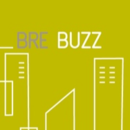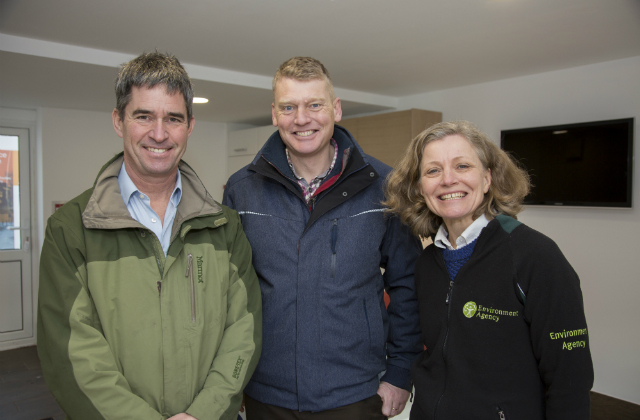Building flood resilience
Chair of the Environment Agency, Emma Howard Boyd and BRE Chief Executive Peter Bonfield, share their thoughts on improving our ability to cope with and recover from flooding.
[BRE's Peter Bonfield (left) with BBC 'Countryfile' presenter Tom Heap and Emma Howard Boyd at the BRE flood house]
Our climate is changing. We are seeing more extreme weather events which could lead to increases in heavy rainfall and significantly increased risks from river and surface water flooding.
A growing population means more houses, which means more people will be at risk.
Over 5 million households and businesses in England – that’s 1 in 6 – are currently at risk of flooding with 2.4 million properties from river or coastal flooding and 3 million from surface water. And perhaps the most important fact of all – there is no such thing as 100% flood protection.
But it is possible to improve our resilience to the ever increasing risk of flooding.
Following the devastating winter flooding of 2015/16, the Environment Agency and BRE joined forces to publish the property flood resilience action plan.
Its recommendations represent a significant commitment to help manage the impact flooding has on lives and livelihoods. And as part of the actions, the Environment Agency will be working with industry to develop a voluntary code for flood resilience measures. We believe this will support the effective uptake of measures for properties at high flood risk.
The property flood resilience action plan was also a great example of how the best results are achieved when people work in partnership. Flooding has the potential to threaten all of us and we need to tackle it together. And that was the spirit of the report. Ourselves and a range of players from charities, insurance, loss adjusting, business, legal, surveying and flood recovery industries came together to improve people’s lives.
[Using fire hoses to flood the BRE flood house showing its resilience]
It is the same attitude that enabled the completion of the Flood Resilient Repair House at BRE’s Innovation Park. Its main aim is to raise awareness amongst contractors of the most effective ways to repair and refurbish a house that has been flooded and may be at risk of flooding again. It is has a range of adaptions such as: flood resistant doors and windows; a resilient kitchen; water resistant wallboard and insulation.
It’s an inspired project demonstrating what can be done. And we are in no doubt that it is more cost-effective to make properties more resilient rather than pay to repair the damage following a flood.
It also serves as a reminder that we need to shift the thinking on flood risk and start considering it both as a nationwide issue being tackled by government, and a domestic one householders should take individual steps to address.
Flood risk is not just the responsibility of the local authorities, the Environment Agency, central government and the emergency services. It is everyone’s responsibility.
It is the responsibility of the water, electricity and telecoms companies to ensure that their critical facilities are resilient. It is the responsibility of businesses to ensure that they take reasonable precautions to protect themselves and their workers against flooding.
And it’s the responsibility of individual householders too.
The Environment Agency provides plenty of information to help people understand their flood risk. If you have a house in the flood plain, you need to know that you are at risk; you need to know what to do to reduce that risk; and you need to know what to do when it materialises, because it eventually will.
Looking forward, the government’s £2.5 billion spending over the next five years will better protect 300,000 properties through a combination of fixed flood defences and a catchment wide approach to work with natural processes. This will complement community flood plans and property level resilience measures.
But we know communities don’t want higher and higher walls and defences. This wouldn’t be the right option. Resilience at a national and individual level has to be built into the fabric of Britain.
This article was published by BRE Buzz here on 20 Feb 2017. It was written by Emma Howard Boyd.
--BRE Buzz
[edit] Related articles on Designing Buildings Wiki
- Applying flood resilience technologies GG 84.
- BRE Buzz articles on Designing Buildings Wiki.
- BREEAM Flood risk management.
- BS 851188.
- Building Back Better: Resilience.
- Designing resilient cities: a guide to good practice (EP 103).
- Environment Agency.
- Flood.
- Flood and Water Management Act.
- Flood resilient construction.
- Flood risk.
- Flood risk management plans.
- Future flood prevention.
- Managing and responding to disaster.
- Property flood resilience.
- Resilience.
- Ten years on – Lessons from the Flood on building resilience.
- Water framework directive.
Featured articles and news
The UK's Modern Industrial Strategy: A 10 year plan
Previous consultation criticism, current key elements and general support with some persisting reservations.
Building Safety Regulator reforms
New roles, new staff and a new fast track service pave the way for a single construction regulator.
Architectural Technologist CPDs and Communications
CIAT CPD… and how you can do it!
Cooling centres and cool spaces
Managing extreme heat in cities by directing the public to places for heat stress relief and water sources.
Winter gardens: A brief history and warm variations
Extending the season with glass in different forms and terms.
Restoring Great Yarmouth's Winter Gardens
Transforming one of the least sustainable constructions imaginable.
Construction Skills Mission Board launch sector drive
Newly formed government and industry collaboration set strategy for recruiting an additional 100,000 construction workers a year.
New Architects Code comes into effect in September 2025
ARB Architects Code of Conduct and Practice available with ongoing consultation regarding guidance.
Welsh Skills Body (Medr) launches ambitious plan
The new skills body brings together funding and regulation of tertiary education and research for the devolved nation.
Paul Gandy FCIOB announced as next CIOB President
Former Tilbury Douglas CEO takes helm.
UK Infrastructure: A 10 Year Strategy. In brief with reactions
With the National Infrastructure and Service Transformation Authority (NISTA).
Ebenezer Howard: inventor of the garden city. Book review.
The Grenfell Tower fire, eight years on
A time to pause and reflect as Dubai tower block fire reported just before anniversary.
Airtightness Topic Guide BSRIA TG 27/2025
Explaining the basics of airtightness, what it is, why it's important, when it's required and how it's carried out.
Construction contract awards hit lowest point of 2025
Plummeting for second consecutive month, intensifying concerns for housing and infrastructure goals.
Understanding Mental Health in the Built Environment 2025
Examining the state of mental health in construction, shedding light on levels of stress, anxiety and depression.
























